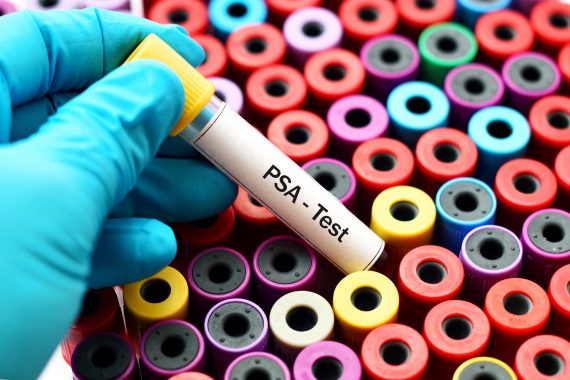GPs should take over responsibility for following up with stable prostate cancer patients and offer them six-monthly reviews, NICE has suggested.
The current NICE guideline recommends that prostate cancer patients remain under hospital care for at least two years from when their PSA levels were first measured as stable, however NICE now wants patients transferred to primary care after just six months.
This forms part of new draft guidelines for prostate cancer, which also says general practice should manage patients where there is a low suspicion of prostate cancer, or where tests have confirmed prostate cancer but no treatment has been recommended.
The draft recommendations, published last week, said that following prostate cancer treatment, and after the initial six months’ follow up, secondary care clinicians should ‘consider a non-hospital based follow-up strategy for people with a stable PSA who have had no significant treatment complications’.
GPs should invite these patients to have their PSA levels checked ‘at least every six months for the first two years’ and then ‘at least once a year’ following that, NICE added.
GPs should also take responsibility for patients with a low level of suspicion for prostate cancer – those who have negative MRI or biopsy results – according to the guidelines.
For those without biopsy results, PSA follow-ups should be performed at six months and then every year, while those with negative results should have follow-ups every two years.
In addition, NICE wants GPs to take on the follow-up treatment for patients who have prostate cancer but who are not in treatment – patients on a ‘watchful waiting regimen with no curative intent’ – offering these PSA testing ‘at least once a year’.
BMA GP Committee clinical and prescribing policy lead Dr Andrew Green said: ‘What is vital is that the out-of-hospital care is done through a properly commissioned scheme which ensures that patients do not get lost to follow-up and are cared for with adequate resources.
‘There are good examples of this happening in many areas, often aided by dedicated IT which can guide non-specialists as to the importance of any biochemical changes found.’
The new guidance comes at the same time as a new study suggests GPs should lead prostate cancer patient follow-ups to reduce workload for urologists and improve continuity of care.
The study, published last week in the BJGP Open, suggests that GPs should lead prostate cancer patient follow-ups to reduce workload for urologists and improve continuity of care.
The research tested the feasibility of a GP-led prostate cancer follow-up pathway with a small cohort, and concluded that it was ‘successful’ and warranted a ‘larger study to provide evidence for the (cost-)effectiveness’ of such a pathway.
Recommendations in full:
If the MRI or biopsy is negative:
- For people who have a raised PSA, and MRI Likert score of 1 or 2 and have not had a prostate biopsy, repeat PSA test at 3–6 months and:
- offer prostate biopsy if there is a strong suspicion of prostate cancer (for example, PSA density greater than 0.15 ng/ml/ml or PSA velocity greater than 0.75 ng/year, or strong family history), taking into account their life expectancy and comorbidities
- discharge the person to primary care if the level of suspicion is low: advise PSA follow-up at 6 months and then every year, and set a level for primary care at which to re-refer based on PSA density 2 (0.15 ng/ml/ml) or velocity (0.75 ng/year). [2019]
- For people who have a raised PSA, an MRI Likert score of 1 or 2 (or a 4 contraindication to MRI), and negative biopsy, repeat PSA at 3–6 months and:
- offer prostate biopsy if there is a strong suspicion of prostate cancer (for example, PSA density greater than 0.15 ng/ml/ml or PSA velocity greater than 0.75 ng/year, or strong family history), taking into account their life expectancy and comorbidities
- discharge the person to primary care if the level of suspicion is low: advise PSA follow-up every 2 years, and set a PSA level for primary care at which to re-refer, based on PSA density (0.15 ng/ml/ml) or velocity (0.75 ng/year). [2019]
Follow ups:
- Check PSA levels for all people with prostate cancer who are having radical treatment no earlier than 6 weeks after treatment, at least every 6 months for the first 2 years, and then at least once a year after that. [2019]
- After at least 6 months’ initial follow-up, consider a non-hospital based follow-up strategy for people with a stable PSA who have had no significant treatment complications, unless they are taking part in a clinical trial that needs formal clinic-based follow-up. [2019]
- Follow up people with prostate cancer who have chosen a watchful waiting regimen with no curative intent in primary care if protocols for this have been agreed between the local urological cancer MDT and the relevant primary care organisation(s). Measure their PSA at least once a year. [2019]
Source: NICE
Pulse October survey
Take our July 2025 survey to potentially win £1.000 worth of tokens

Visit Pulse Reference for details on 140 symptoms, including easily searchable symptoms and categories, offering you a free platform to check symptoms and receive potential diagnoses during consultations.












